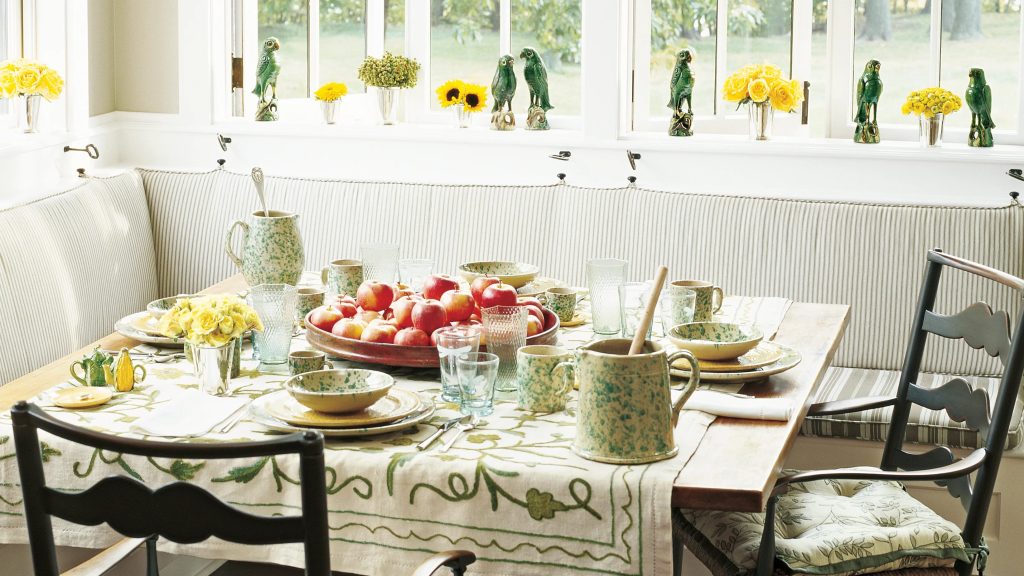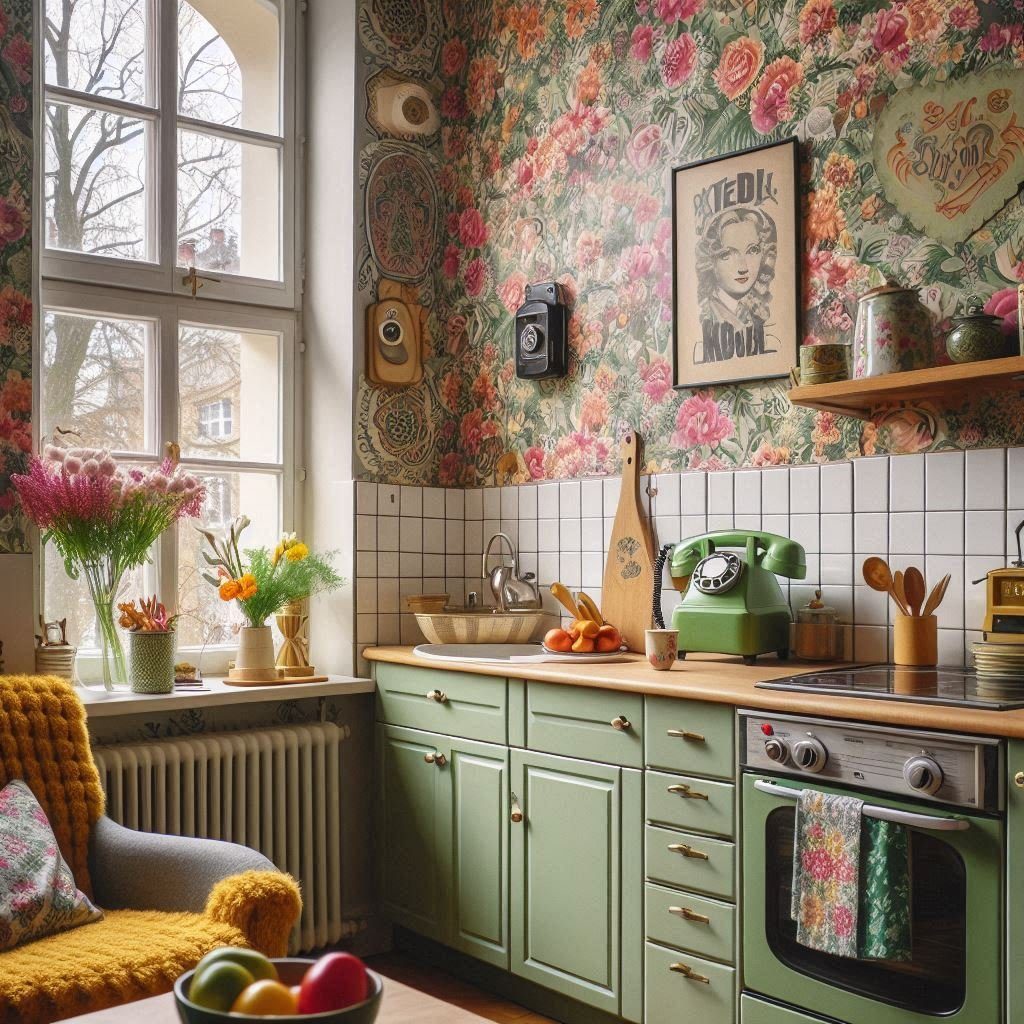The kitchen has always been more than just a utilitarian space for culinary creation; it’s a sanctuary of memories, familial warmth, and aesthetic expression.
In recent years, the resurgence of retro design has captivated homeowners and interior enthusiasts alike, offering a sentimental voyage through decades past.
Retro Kitchen Ideas
From the vibrant chromatic palettes of the 1950s to the earthy, organic textures of the 1970s, retro kitchen design transcends mere decoration—it’s a comprehensive narrative of cultural evolution, embodying the quintessential charm of bygone eras while simultaneously embracing contemporary functionality.
1. Pastel Color Palette Magic

The 1950s were synonymous with soft, delicate color palettes that transformed kitchens into whimsical spaces of joy and optimism. Imagine mint green refrigerators, powder blue cabinets, and blush pink countertops creating a harmonious symphony of gentle tones. These pastel shades weren’t just colors; they were a statement of post-war positivity and domestic tranquility.
Incorporating pastel colors requires a delicate balance. Modern interpretations can blend these vintage hues with contemporary materials like stainless steel appliances or sleek marble countertops. The key is to create a dialogue between nostalgia and current design sensibilities, ensuring the space feels both familiar and fresh.
2. Vintage Appliance Revival

Vintage appliances are more than decorative elements; they’re functional art pieces that tell stories of technological evolution. Restored mid-century refrigerators with rounded edges, classic gas stoves in vibrant enamel finishes, and chrome-trimmed mixers represent more than mere kitchen equipment—they embody an era of craftsmanship and design integrity.
Collectors and design enthusiasts have sparked a renaissance in preserving and restoring these iconic appliances. While original pieces can be expensive and less energy-efficient, numerous contemporary manufacturers now produce retro-styled appliances that combine vintage aesthetics with modern technology.
3. Checkered Flooring Comeback

Checkered floors have been a quintessential element of retro kitchen design, particularly prominent in 1950s and 1960s interiors. Black and white tiles, typically in ceramic or linoleum, created dynamic visual patterns that transformed kitchen floors into artistic canvases. These geometric designs weren’t just decorative; they symbolized an era’s precision and modernist aesthetic.
Contemporary interpretations offer more flexibility, with variations in color, material, and scale. Porcelain tiles, luxury vinyl, and even modern linoleum options allow homeowners to capture the classic checkered look while benefiting from advanced durability and maintenance features.
4. Formica Countertops Renaissance

Formica countertops epitomize the democratization of design in mid-century America. These affordable, versatile surfaces came in an array of patterns—from boomerang motifs to starbursts—that captured the era’s optimistic, forward-looking spirit. Far from being mere budget alternatives, these countertops were design statements that made stylish interiors accessible to middle-class households.
Modern Formica technologies have significantly improved, offering enhanced durability, more sophisticated designs, and better resistance to wear and tear. Contemporary versions can beautifully mimic natural stone while maintaining the nostalgic charm of vintage surfaces.
Related Guide: 16 Inspiring Brown Kitchen Ideas
5. Diner-Inspired Breakfast Nooks

The classic American diner aesthetic has profoundly influenced kitchen design, particularly in creating intimate breakfast nooks. Vinyl-upholstered booth seating, chrome-rimmed tables, and vibrant color schemes transport users to an era of casual, convivial dining. These spaces are more than eating areas; they’re social hubs that encourage conversation and connection.
Contemporary interpretations might blend retro elements with modern ergonomics, using updated materials and more comfortable seating designs while preserving the essential character of these charming dining spaces.
6. Open Shelving with Vintage Dishes

Vintage dishes are more than just functional kitchenware; they’re tangible pieces of design history. Displaying classic Pyrex, Depression-era glassware, or mid-century ceramic collections transforms open shelving into curated exhibitions of culinary nostalgia. These displays not only add visual interest but also tell stories of family traditions and cultural heritage.
Careful curation is essential when creating these displays. Mix vintage pieces with contemporary elements to prevent the space from feeling like a museum. Use modern brackets, strategic lighting, and complementary color schemes to integrate these historical pieces seamlessly into contemporary kitchen design.
7. Retro Color Block Painting

Color blocking emerged as a powerful design trend in mid-century modern interiors, and kitchens are the perfect canvas for this artistic approach. Bold geometric color sections can transform ordinary walls into extraordinary design statements. Think vibrant yellows contrasting with deep blues or soft greens paired with crisp whites.
Modern color blocking techniques offer more nuanced approaches. Instead of strictly geometric divisions, contemporary designers play with organic shapes, gradient transitions, and unexpected color combinations that pay homage to retro aesthetics while feeling distinctly current.
8. Atomic Age Hardware and Accessories

The Atomic Age brought distinctive design elements that continue to captivate design enthusiasts. Starburst clocks, sputnik-inspired light fixtures, and hardware with geometric or sunburst designs epitomize this era’s fascination with space-age aesthetics. These accessories are more than decorative elements; they’re conversation pieces that reflect an optimistic, forward-looking design philosophy.
When incorporating these elements, balance is crucial. A few well-chosen pieces can create visual interest without overwhelming the space. Mix vintage finds with modern interpretations to create a cohesive, contemporary look that respects historical design languages.
9. Terrazzo Resurgence

Terrazzo, a composite material featuring chips of marble, quartz, granite, or glass, has experienced a remarkable design renaissance. Once considered dated, this material now represents sophisticated, sustainable design. Its ability to incorporate recycled materials and create unique, speckled patterns makes it both nostalgic and forward-thinking.
Contemporary terrazzo applications extend beyond floors. Countertops, backsplashes, and even custom furniture pieces showcase this material’s versatility. Modern color palettes and manufacturing techniques have elevated terrazzo from a budget option to a high-end design choice.
10. Vintage Wallpaper Statements

Wallpapers from the 1950s and 1960s were bold, expressive, and unabashedly maximalist. Large-scale botanical prints, geometric patterns, and whimsical designs transformed kitchen walls into artistic canvases. These wallpapers weren’t just decorative; they were statements of personal style and cultural zeitgeist.
Contemporary wallpaper technologies offer unprecedented customization. Digital printing allows for precise reproductions of vintage designs, while modern materials provide better durability and easier maintenance. Accent walls or carefully selected panels can introduce these nostalgic patterns without overwhelming the entire space.
11. Kitchen Island with Vintage Bar Stools

Vintage bar stools, particularly those from the mid-century era, bring dynamic personality to kitchen islands. Chrome legs, vinyl upholstery, and distinctive shapes transform functional seating into design statements. These pieces represent an era when everyday objects were designed with both form and function in mind.
When selecting vintage bar stools, consider comfort and structural integrity. While original pieces are charming, modern reproductions often provide better ergonomic support and durability. Mix vintage styles with contemporary kitchen elements to create a balanced, eclectic aesthetic.
Related Guide: 12 Perfect Kitchens with Dark Brown Cabinets
12. Rounded Corners and Organic Shapes

The mid-century design philosophy emphasized organic, flowing lines that rejected sharp angles. Kitchen elements with rounded corners—from cabinet designs to appliance shapes—reflect this design ethos. Soft, curved islands, circular dining tables, and rounded cabinet edges create spaces that feel simultaneously nostalgic and contemporary.
Modern manufacturing techniques allow for more sophisticated interpretations of these organic forms. Advanced materials and design technologies enable the creation of smooth, flowing kitchen elements that honor historical design principles while meeting contemporary functional requirements.
13. Pendant Lighting with Vintage Flair

Lighting can dramatically transform kitchen aesthetics. Vintage-inspired pendant lights, particularly those with metallic finishes, geometric shapes, or cascading designs, serve as both illumination sources and artistic focal points. These fixtures draw inspiration from mid-century modern and industrial design movements.
Contemporary lighting designers continue to reinterpret classic pendant styles. Materials like brushed copper, matte black finishes, and innovative glass techniques allow for fresh takes on vintage lighting concepts. Strategic placement and thoughtful selection can elevate kitchen lighting from mere functionality to design artistry.
14. Green and Sustainable Vintage Approach

Sustainability and vintage design are increasingly interconnected. Repurposing vintage kitchen elements, selecting energy-efficient appliances with retro aesthetics, and incorporating reclaimed materials represent a holistic approach to nostalgic design. This approach respects historical design languages while addressing contemporary environmental concerns.
Consider vintage pieces that can be responsibly restored, select reproduction items made with sustainable practices, and prioritize quality over quantity. The most successful retro kitchen designs balance aesthetic appreciation with environmental consciousness.
15. Mixing Modern with Vintage Elements

The most sophisticated retro kitchen designs don’t merely replicate historical styles—they create dialogues between past and present. Mixing vintage statement pieces with contemporary elements creates dynamic, personalized spaces that feel both familiar and innovative.
Strategic juxtaposition is key. A vintage refrigerator might sit alongside sleek modern cabinetry, or mid-century bar stools could complement a minimalist kitchen island. The goal is to create a space that feels curated, personal, and timeless.
Conclusion
Retro kitchen design is more than a nostalgic trend—it’s a celebration of design history, craftsmanship, and personal expression. By thoughtfully incorporating vintage elements, homeowners can create spaces that honor the past while meeting contemporary lifestyle needs.
The most successful retro kitchens are those that balance historical appreciation with modern functionality, creating environments that are simultaneously familiar and exciting.

